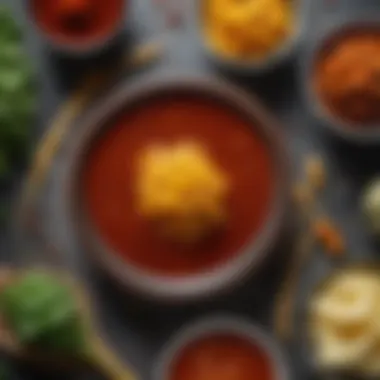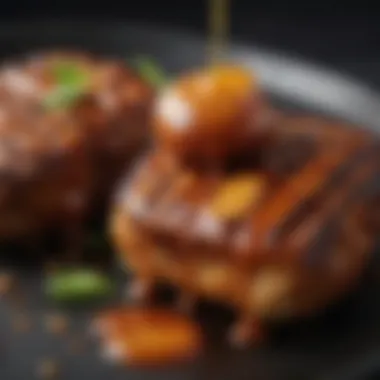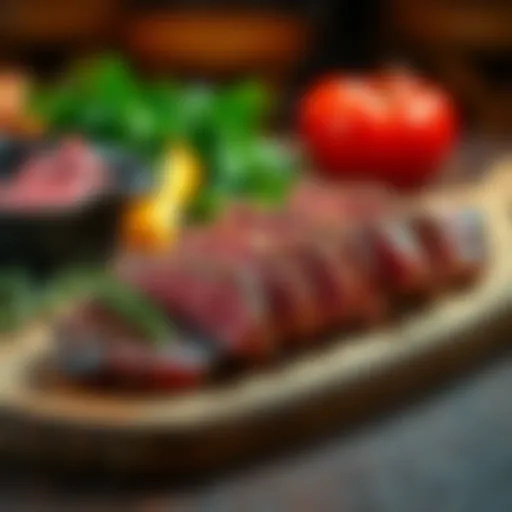Crafting the Perfect Honey Barbecue Sauce


Intro
Crafting a flavorful honey barbecue sauce is both an art and a science. This guide will take you through the essentials of making a sauce that can elevate your dishes to new heights. Understanding the components allows for a balanced flavor and satisfying texture that enhances any meal.
Many people enjoy barbecue sauce, but few realize the intricacies behind perfecting it. This condiment can complement a variety of dishes, from grilled meats to roasted vegetables. By the end of this guide, novice and experienced cooks alike will gain insights into creating a honey barbecue sauce tailored to their palate.
Recipe Overview
Recipe Name
Homemade Honey Barbecue Sauce
Cuisine Type
American
Ingredients
List of Ingredients with Measurements
To create this delightful sauce, you will need:
- 1 cup ketchup
- 1/2 cup honey
- 1/4 cup apple cider vinegar
- 2 tablespoons Worcestershire sauce
- 1 tablespoon Dijon mustard
- 1 tablespoon smoked paprika
- 1 teaspoon garlic powder
- 1 teaspoon onion powder
- Salt and pepper to taste
Substitutions for Common Ingredients
While the ingredients above create a classic honey barbecue sauce, consider these substitutions:
- Instead of ketchup, you can use tomato paste or puree for a thicker consistency.
- Maple syrup can replace honey, offering a different sweetness profile.
- White vinegar may be used in place of apple cider vinegar, though it will adjust the flavor slightly.
- For a gluten-free option, ensure that the Worcestershire sauce is made without gluten-containing ingredients.
Creating a honey barbecue sauce is straightforward when equipped with the right ingredients. With careful measurements and quality components, even a novice cook can produce a mouth-watering sauce.
Prelims to Honey Barbecue Sauce
Honey barbecue sauce is an essential component in many culinary traditions. Its unique blend of sweetness and richness sets it apart from other sauces. This introduction aims to shed light on the significance of honey barbecue sauce in the culinary arts, outlining its benefits and considerations.
One primary element is the versatility of this sauce. It pairs well with various proteins and vegetables, enhancing their flavors significantly. Whether drizzled on grilled chicken or used as a marinade, this sauce adds a distinct taste. Its sweetness from honey balances well with the spiciness of barbecue flavors, creating a nuanced flavor profile.
From a nutritional standpoint, honey barbecue sauce offers benefits. Honey is known for its antioxidant properties. Incorporating it into cooking can provide health advantages, such as boosting immunity and promoting digestive health. This makes the sauce not just delicious, but also a healthier option compared to many commercial sauces loaded with artificial ingredients.
Moreover, crafting your own honey barbecue sauce allows for customization. You control the sugar content, spice level, and ingredient quality. This aspect appeals to those who are health-conscious and those who appreciate home cooking.
It is also worth noting the cultural importance of barbecue sauces in general. They often carry regional distinctive traits. Honey barbecue sauce can reflect local tastes and preferences, making it a canvas for personal expression in cooking.
"Creating your own version of honey barbecue sauce connects you deeper with the culinary traditions of your region."
In summary, honey barbecue sauce deserves attention not only for its flavor but also for its adaptability and health benefits. As we progress in this guide, we will detail the ingredients, cooking techniques, and variations that can elevate any dish. Understanding this sauce fully will enhance your culinary repertoire.
Understanding the Ingredients
Understanding the ingredients is crucial when crafting honey barbecue sauce. Each element contributes to the overall flavor, texture, and balance of the sauce. The choice of ingredients can elevate the dish, offering sweet, tangy, and umami notes.
Honey, as the star component, provides sweetness and viscosity, setting a foundation for the sauce. Its quality can greatly influence the final product. Aside from honey, the barbecue sauce base typically includes a mixture of vinegar, tomato products, and various seasonings.
Complementary ingredients, such as spices and additional acids, also play a significant role. These details can enhance the complexity, making the sauce suitable for a wide range of foods. Overall, being knowledgeable about these components is the first step towards creating a well-rounded and flavorful honey barbecue sauce.
Honey: The Sweet Foundation
Honey serves as the sweet foundation of honey barbecue sauce. Its distinctive flavor profile provides not only sweetness but also depth. Unlike refined sugars, honey comes with unique floral notes influenced by the source of the nectar. This complexity can enhance the sauce, making it more flavorful and memorable.


Furthermore, honey imparts a thick, glossy texture that coats the meats well, creating an appealing presentation. Its natural properties allow for better caramelization when cooking, which can deepen the flavor even further. The choice of honey, whether it's wildflower, clover, or another variety, can affect the finished product and should be chosen carefully.
Barbecue Sauce Base: An Overview
The barbecue sauce base is another critical component. Typically, it combines vinegar, tomato products, and a variety of seasonings. The barbecue sauce base provides the necessary acidity and balance to the overall flavor profile. It is essential to select a base that aligns well with the sweetness of the honey.
Usually, the tomato products used are either ketchup or tomato paste. These tomato products not only contribute richness but also a touch of acidity, which helps enhance other flavors in the sauce. This balance is key for achieving that signature barbecue flavor.
Complementary Ingredients
Complementary ingredients assist in creating layers of flavor and nuance in honey barbecue sauce.
Spices and seasonings
Spices and seasonings are vital in enhancing the sauce. They add warmth, complexity, and a slight kick. Ingredients such as garlic powder, onion powder, smoked paprika, and black pepper can all add depth. Their key characteristic is the ability to bring contrasting flavors into harmony. This balance creates a more sophisticated profile than just sweet and tangy. Popular choices also include cayenne pepper for heat or cumin for an earthy touch.
The unique feature of spices lies in their ability to blend seamlessly into sauce. This can result in subtle yet impactful flavors that enrich the overall outcome, making for an intriguing culinary experience. Nonetheless, overusing spices could lead to an overpowering taste, so it necessitates careful measurement.
Vinegar for acidity
Vinegar plays a crucial role in balancing the sweet notes of honey. The acidity cuts through the richness, preventing the sauce from becoming overly sweet. Different types of vinegar, such as apple cider or white vinegar, can impart their distinct flavors, enhancing the overall taste.
The characteristic of vinegar is its sharpness, which adds zing. It is a popular choice in many barbecue sauces due to its versatility. However, using too much can overshadow other flavors, so it should be added gradually, based on personal taste preference.
Tomato products
Tomato products bring body and richness to honey barbecue sauce. Ketchup, commonly used, introduces sweetness and acidity, which enhances the overall flavor profile. Its key characteristic is its thick texture, which contributes to the sauce's overall consistency.
Tomato paste provides even more depth and intensity, making it a beneficial component as well. The unique feature of tomato products is their ability to meld with other ingredients, enhancing the sauce without dominating it. However, it is important to use high-quality products to avoid an overly sweet or artificial flavor that might detract from the sauce's overall appeal.
Essential Cooking Techniques
Understanding essential cooking techniques is vital when crafting honey barbecue sauce. These methods influence the flavor profile, texture, and overall quality of the sauce. Each cooking step contributes significantly to creating a successful condiment that enhances various dishes. The techniques outlined below will guide you in developing a well-rounded sauce that meets both taste and consistency expectations.
Preparing the Sauce Base
The preparation of the sauce base is the first and one of the most crucial steps in crafting honey barbecue sauce. It lays the groundwork for achieving a harmonious blend of flavors. The base usually consists of tomato paste or ketchup, which serves as the primary component. Start by measuring the right amount based on your desired yield.
When combining your primary ingredient, ensure a careful balance with honey and other flavoring agents. An even mixture at this stage sets the tone for the sauce's flavor profile. If done properly, the sauce will carry the sweetness of honey, counterbalanced by the acidity of vinegar and the spiciness of added seasonings.
Simmering for Depth of Flavor
Simmering is another pivotal step that should not be underestimated. It allows the ingredients to meld and develop deeper flavors. This process usually takes approximately 20 to 30 minutes. During simmering, the sauce thickens as water evaporates.
Keep in mind that frequent stirring is essential to prevent burning. Ideally, you should cook on low to medium heat, which helps maintain a consistent temperature. This controlled cooking method allows the sugars in the honey to caramelize slightly, enhancing the overall taste of the sauce.
"Simmering not only deepens the flavors but also transforms your sauce into a cohesive condiment beyond its individual ingredients."
Balancing Texture and Consistency
Achieving the right texture and consistency is the final touch that defines honey barbecue sauce. If the sauce is too thick, it can become difficult to spread or dip. Conversely, a runny sauce lacks substance. To adjust the texture, consider adding a little water or vinegar during the cooking process.
Alternatively, if your sauce is too loose, you can cook it down further to thicken it appropriately. The mortality of your sauce plays a critical role in how it adheres to food. A well-balanced sauce should stick to meat or vegetables without dripping excessively.
In summary, mastering these essential cooking techniques will elevate your honey barbecue sauce to new heights. From preparation to simmering and balancing, each technique contributes to an impressive culinary outcome.
Step-by-Step Recipe Development
Crafting honey barbecue sauce is not simply about combining ingredients; it requires a thoughtful method to ensure the final product is both delicious and versatile. This step-by-step approach reveals the significance of each phase in creating a balanced sauce that meets various culinary needs. Attention to detail and adherence to the process benefits both novice and experienced cooks alike, enhancing their understanding and execution.
Gathering Ingredients


The first step in developing honey barbecue sauce is gathering your ingredients. Each ingredient plays an integral role in shaping the flavor and consistency of the sauce.
- Honey: Choose high-quality honey for the best sweetness. Local or raw honey often brings unique flavor notes.
- Barbecue Sauce Base: Look for a base that you enjoy; it could be a commercial brand or homemade. This provides the required tanginess and depth.
- Complementary Ingredients: Spices such as paprika, garlic powder, or onion powder can enhance flavors, while vinegar adds acidity. Tomato products, whether paste or sauce, contribute to the texture.
Select items that are fresh and free of artificial preservatives whenever possible. The overall quality of these components directly influences the final outcome.
Mixing the Components
Mixing the ingredients correctly is crucial for creating honey barbecue sauce. This phase permits individual flavors to meld harmoniously.
- In a mixing bowl, combine your chosen barbecue sauce base with the honey. Start with a ratio that balances sweetness and tang. A common starting point is one part honey to two parts barbecue sauce.
- Add the spices and vinegar gradually, which allows you to control the flavor profile. Taste as you go to achieve the desired balance.
- Thoroughly mix until a homogenous mixture forms. Consistency matters; take your time mixing to avoid clumping.
This phase not only involves blending but also understanding how flavors interact, ensuring each bite delivers a satisfying experience.
Cooking Process Explained
The cooking phase serves to deepen flavors and meld the ingredients together. This step enhances the sauce's overall character.
- Simmering: Place the mixed sauce in a saucepan and bring it to a gentle simmer over low heat. This allows the flavors to evolve and intensify.
- Duration: Simmer the mixture for at least 15 to 20 minutes, stirring occasionally to prevent sticking. Longer simmering will result in a more robust taste.
- Adjusting Consistency: If the sauce becomes too thick, add water or more vinegar to thin it out. Conversely, if too thin, simmer longer to reduce.
This process is essential in transforming raw ingredients into a complex sauce. It is where the characteristics of each item truly emerge.
Final Touches
The final touches of honey barbecue sauce involve refining its flavor and preparing it for use.
- Taste Test: At this point, take a moment to taste the sauce. You might find it requires additional seasoning, more honey, or a touch more vinegar.
- Cooling: Allow the sauce to cool before bottling. This prevents condensation and maintains consistency.
- Storage Preparation: Transfer the cooled sauce into a clean jar or bottle. Ensure that seals are tight to preserve freshness.
Remember, the time and care invested in each step result in a superior product.
"Quality is never an accident; it is always the result of intelligent effort."
Following these steps systematically will lead to a honey barbecue sauce that elevates meals and impresses guests. Crafting this condiment can be a rewarding endeavor, opening doors to culinary creativity in various dish presentations.
Serving Suggestions
In the realm of culinary arts, serving suggestions hold significant value. They bridge the gap between preparation and enjoyment, enhancing the overall dining experience. For honey barbecue sauce, these recommendations can guide not just how to use the sauce but also inform on what flavors and textures complement it best. Knowing how to serve this sauce effectively can elevate various dishes, making them more enjoyable and satisfying.
Pairing with Meats
When considering meats to pair with honey barbecue sauce, one must think about the balance of flavors. This sauce works exceptionally well with grilled, baked, or smoked meats due to its sweet and tangy profile. Options such as chicken, ribs, and brisket often come to mind as they absorb the flavors beautifully.
- Chicken: Marinated chicken thighs or wings coated with honey barbecue sauce offer a delightful fusion of sweetness and savory notes. The sauce caramelizes nicely when grilled, creating a rich crust.
- Pork Ribs: The tender surface of slow-cooked pork ribs provides a perfect canvas for sweet flavors, enhancing the natural richness of the meat. Glaze the ribs during the last stages of cooking for best results.
- Brisket: For brisket lovers, honey barbecue sauce can act as a flavorful dip or glaze after the meat has been smoked, providing a contrast to the smoky taste.
Each of these meats contributes their unique characteristics, allowing the honey barbecue sauce to shine and create a well-rounded plate. The combination of sweet and savory elements invites intricate taste experiences, making meals memorable.
Vegetarian Applications
Honey barbecue sauce is not limited to meats; it can also complement a range of vegetarian dishes. This versatility expands its appeal to a wider audience, catering to different dietary preferences. Using this sauce creatively can transform simple vegetables into gourmet delights.
- Grilled Vegetables: Vegetables like zucchini, bell peppers, and mushrooms can be brushed with honey barbecue sauce before grilling. The sauce will enhance their natural flavors and provide a lovely glaze.
- Tofu: Tofu absorbs flavors well, making it a perfect vehicle for honey barbecue sauce. Marinating tofu cubes in the sauce before grilling or baking adds depth to each bite.
- Cauliflower Wings: For a modern twist, cauliflower florets can be seasoned, roasted, and tossed in honey barbecue sauce, serving as a satisfying and healthier alternative to traditional wings.
These vegetarian applications demonstrate the sauce's adaptability, enriching dishes with its distinctive sweetness. By utilizing honey barbecue sauce in various preparations, it has the potential to appeal to all food lovers, regardless of their dietary restrictions.
Storage and Shelf Life
Understanding how to properly store honey barbecue sauce is vital for maintaining its flavor and quality over time. If stored correctly, homemade or store-bought sauce can enhance not just meals, but also ensure a safer cooking experience. Proper storage can prevent spoilage, preserve taste, and extend shelf life, making it a key topic in this guide.
Best Practices for Storage
When it comes to storing honey barbecue sauce, there are a few best practices to keep in mind:


- Choose the Right Container: Use airtight glass containers or BPA-free plastic bottles. These materials prevent air exposure and minimize contamination risks.
- Keep it Cool: Store the sauce in a cool, dark place. A pantry or cupboard away from sunlight is ideal. Refrigeration is often recommended for homemade sauces to extend their freshness.
- Label the Container: Mark your container with a date. Knowing when you made the sauce helps you track its longevity.
- Avoid Contamination: Use clean utensils when scooping out the sauce. Double-dipping can introduce bacteria into the container.
Following these practices allows you to keep the honey barbecue sauce at its best.
Understanding Expiration Dates
Expiration dates on store-bought honey barbecue sauce are important indicators of freshness. These dates help consumers gauge when the sauce might begin to lose its quality. Here are some key points to understand about expiration:
- Manufactured Dates vs. Expiration Dates: Check labels for both. The manufactured date shows when it was made, while the expiration date tells you until when it should be consumed for best quality.
- Once Opened: An opened bottle usually has a shorter shelf life. Depending on the brand, it can often last between 6 months to 1 year in the refrigerator.
- Signs of Spoilage: If the sauce changes color, texture, or smell, it is best to discard it. Molds or unusual appearance can indicate it has become unsafe to consume.
Always prioritize safety when dealing with food products, as consumption beyond expiration can lead to health risks.
Variations of Honey Barbecue Sauce
Exploring variations of honey barbecue sauce is essential for any culinary enthusiast. Each variation reflects distinct flavor profiles and allows for creative expression in the kitchen. Variations cater to diverse palate preferences, integrating different spices, ingredients, and techniques. By understanding these adaptations, you can elevate mundane dishes, creating memorable meals for family and friends.
Spicy Honey Barbecue Sauce
Spicy honey barbecue sauce is a delightful twist on the classic recipe. This version incorporates heat, usually from ingredients like cayenne pepper, jalapeños, or hot sauce. The balance of sweet and spicy plays a significant role in enhancing meat flavors such as chicken or ribs. To craft this variant:
- Start with a base sauce: Use your traditional honey barbecue sauce recipe as the foundation.
- Add heat: Integrate cayenne pepper or hot sauce gradually, tasting as you go. This ensures you achieve the desired level of spiciness.
- Consider adding aromatics: Onion powder and garlic powder can deepen the flavor.
With these adjustments, you will create a sauce that intrigues the taste buds and sparks conversation at any gathering.
Smoky Honey Barbecue Sauce
Smoky honey barbecue sauce offers a rich, aromatic profile that pairs wonderfully with grilled meats. The smokiness can come from various sources, such as smoked paprika, liquid smoke, or even the grilling process itself. Here’s how to craft this version:
- Choose your smoky element: Smoked paprika adds both color and flavor. Alternatively, liquid smoke can infuse a complex taste. Start with small amounts; too much can dominate the sauce.
- Combine with honey and the base sauce: Blend the smoky components with honey barbecue sauce to create depth.
- Finish with tang: A splash of vinegar can help balance the sweetness with acidity, enhancing the overall flavor.
This variation works particularly well with pulled pork or grilled veggies, providing an elegant touch to any dish.
"Exploring different flavors in your honey barbecue sauce can transform standard meals into culinary delights."
The Role of Honey in Culinary Arts
Honey is not just a sweetener; it plays a crucial role in culinary practices, providing flavor, texture, and a rich history in various cuisines. In the context of honey barbecue sauce, honey serves several specific functions.
First, honey drastically enhances the flavor profile of the sauce. Its natural sweetness helps to balance the acidity of other ingredients like vinegar and tomato products. This balance is essential, as it makes the overall taste more harmonious.
Furthermore, honey contributes to the sauce's texture, ensuring it is smooth and glossy. When cooked, honey caramelizes slightly, adding a depth of flavor that makes barbecue sauce truly memorable. The viscosity of honey also helps to coat meats and vegetables, ensuring that flavors are locked in during the cooking process. Beyond technical aspects, honey has health benefits. It is known for its antioxidant properties, which can elevate the nutritional value of food. These factors make honey an important ingredient in both traditional and modern culinary contexts.
Moreover, different types of honey offer unique flavors. For instance, clover honey has a mild taste, while wildflower honey often has more complex notes. Selecting the right honey can further enhance the final product, making it crucial to understand the variety being used.
Historical Context and Uses
The use of honey in cooking dates back to ancient civilizations. Historically, honey was a precious commodity, used for both culinary and medicinal purposes. Ancient Egyptians, for instance, praised honey for its health benefits and used it in various recipes. It was also an offering to the gods, signifying its importance in their culture.
In many cultures, honey has been a central ingredient in barbecue recipes. The combination of honey with various spices and savory elements can be traced back centuries. In the Southern United States, honey barbecue sauce became especially popular, often associated with grilling during family gatherings and celebrations.
Honey not only sweetens but also acts as a preservative, helping to extend the shelf life of sauces and marinades. This quality was invaluable in times when refrigeration was not available. With such historical weight, honey remains a versatile and cherished ingredient in culinary arts today.
"The lineage of honey in cuisine displays its unmatched ability to transform dishes with little effort."
Understanding the significance of honey extends beyond mere taste—it connects us to a long history of culinary practices and advancements. In crafting your honey barbecue sauce, knowing these elements can deepen the appreciation for what you create.
End
In sum, the journey of crafting honey barbecue sauce encompasses not only the fusion of flavors but also the understanding of ingredients, techniques, and the culinary landscape where it thrives. Honey barbecue sauce stands out as a beloved condiment that can elevate various dishes, making it essential in both casual and formal settings.
This article has highlighted several crucial elements of formulating the perfect sauce. From the sweet foundation of honey to the robust character of barbecue sauce, each ingredient plays a distinct role. During the preparation process, techniques such as simmering can significantly enhance the depth of flavor, ensuring a satisfying consistency.
Considering storage methods will keep this versatile sauce fresh for future meals, maximizing its utility. Awareness of expiration dates also ensures safety and quality in culinary practices.
Additionally, the exploration of variations, such as spicy and smoky options, highlights the adaptability of honey barbecue sauce, making it suitable for a diverse audience with varying taste preferences.
Overall, crafting this sauce is not simply about mixing ingredients; it is about understanding flavors, executing proper techniques, and respecting the art of cooking. These factors culminate in a product that can enhance various culinary experiences. This guide serves to equip both novice and seasoned cooks to explore this condiment in their meals, appreciating its culinary potential.















